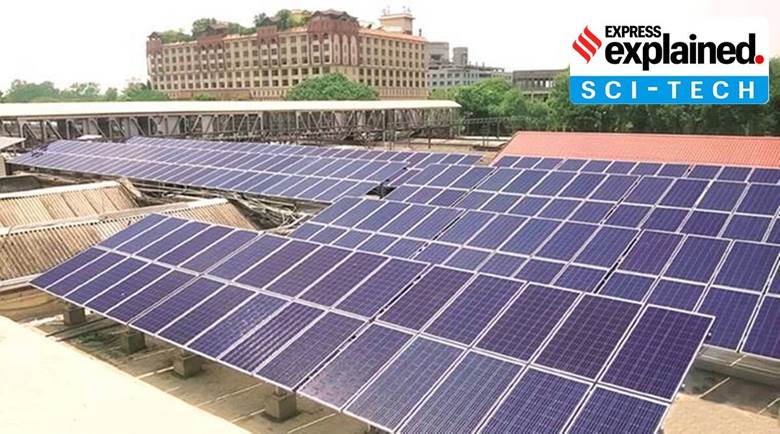SOLAR POWER IN INDIA

Copyright infringement is not intended
Context: Solar photovoltaics (PV) has driven India’s push towards the adoption of cleaner energy generation technologies. From less than 10 MW in 2010, India has added significant PV capacity over the past decade, achieving over 50 GW by 2022.
More on the news:
- By 2030, India is targeting about 500 GW of renewable energy deployment, out of which ~280 GW is expected from solar PV. This necessitates the deployment of nearly 30 GW of solar capacity every year until 2030.
- However, there are challenges that need to be overcome for the sustainability of the PV economy. Indian solar deployment or installation companies depend heavily on imports, as India currently does not have enough module and cell manufacturing capacity.
Key components:
- A typical solar PV value chain consists of first fabricating polysilicon ingots which need to be transformed into thin Si wafers that are needed to manufacture the PV mini-modules.
- The mini-modules are then assembled into market-ready and field-deployable modules.
- India’s current solar module manufacturing capacity is limited to ~15 GW per year.
- The demand-supply gap widens as we move up the value chain — for example, India only produces ~3.5 GW of cells currently.
- India has no manufacturing capacity for solar wafers and polysilicon ingots, and currently imports 100% of silicon wafers and around 80% of cells even at the current deployment levels.
- Also, out of the 15 GW of module manufacturing capacity, only 3-4 GW of modules are technologically competitive and worthy of deployment in grid-based projects. India remains dependent on import of solar modules for field deployment.
Current govt policy:
- The government has identified this gap, and is rolling out various policy initiatives to push and motivate the industry to work towards self-reliance in solar manufacturing, both for cells and modules.
- Key initiatives include a 40% duty on the import of modules and 25% duty on the import of cells, and a PLI scheme to support manufacturing capex.
- Also, it is mandatory to procure modules only from an approved list of manufacturers (ALMM) for projects that are connected to state/ central government grids; so far, only India-based manufacturers have been approved.
- While this will certainly help to motivate industry, the major challenges are related to size and technology.
Size and technology:
- Most of the Indian industry is currently tuned to handling M2 wafer size, which is roughly 156 x 156 mm2, while the global industry is already moving towards M10 and M12 sizes, which are 182 x 182 mm2 and 210 x 210 mm2 respectively.
- The bigger size has an advantage in terms of silicon cost per wafer, as this effectively means lower loss of silicon during ingot to wafer processing.
- In terms of cell technology, most of the manufacturing still uses Al-BSF technology, which can typically give efficiencies of ~18-19% at the cell level and ~16-17% at the module level.
- By contrast, cell manufacturing worldwide has moved to PERC (22-23%), HJT(~24%), TOPCON (23-24%) and other newer technologies, yielding module efficiency of >21%.
- Producing more solar power for the same module size means more solar power from the same land area. Land, the most expensive part of solar projects, is scarce in India — and Indian industry has no choice but to move towards newer and superior technologies as part of expansion plans.
Raw materials supply:
- There is a huge gap on the raw material supply chain side as well.
- Silicon wafer, the most expensive raw material, is not manufactured in India.
- India will have to work on technology tie-ups to make the right grade of silicon for solar cell manufacturing — and since >90% of the world’s solar wafer manufacturing currently happens in China, it is not clear how and where India will get the technology.
- Other key raw materials such as metallic pastes of silver and aluminium to form the electrical contacts too, are almost 100% imported.
- India is more of an assembly hub than a manufacturing one, and in the long term, it would be beneficial to move up the value chain by making components that could drive the price and quality of both cells and modules.
Academics plus industry:
- Establishing state-of-the-art manufacturing facilities for cells, modules, and raw material needs access to technology. It is unlikely that companies that have spent millions of dollars on in-house and external R&D would make it easy for India to access the latest technologies easily or at a lower cost.
- India has hardly invested in creating high-quality high-TRL technology centres such as IMEC Belgium or the Holst Centre in the Netherlands, which can help the industry to try and test the technologies in a cost-effective manner.
- India needs to create such industry-like centres to work on specific technology domains with clear roadmaps and deliverables for the short and long term, monitored by a right mix of specialists from industry and academia.
Conclusion:
- Although India is making great progress in the deployment of solar PV modules for power generation, its path to become a manufacturing hub for the same requires more than just putting some tax barriers and commercial incentives in the form of PLI schemes, etc.
- It will warrant strong industry-academia collaboration in an innovative manner to start developing home-grown technologies which could, in the short-term, work with the industry to provide them with trained human resource, process learnings, root-cause analysis through right testing and, in the long term, develop India’s own technologies.
- High-end technology development requires substantial investment in several clusters which operate in industry-like working and management conditions, appropriate emoluments, and clear deliverables.




1.png)
